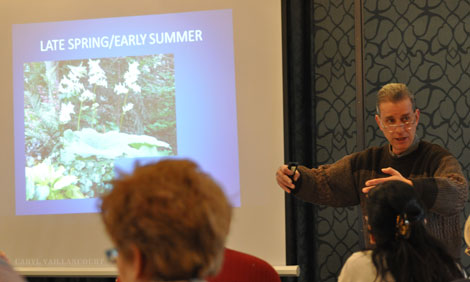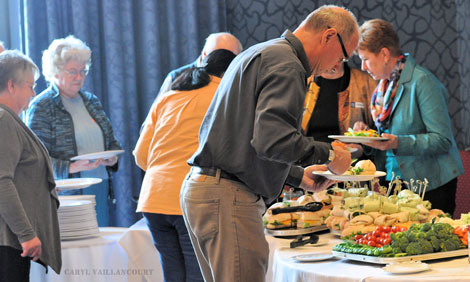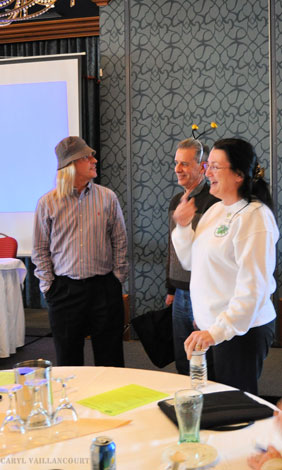|
|
What
a gorgeous
day it was, leaving my house in the Caledon Hills at 7 a.m. with the
birds
singing and spring in the air. I was on my way to Toronto’s “airport
strip” to
pick up two of our guest speakers for the event. When I arrived, I got
out of
my vehicle and was met by Rob Mortko and Don Dean.
To my huge surprise and delight, out walked
Kathy and Mike Shadrack, too. Well,
all hugs
and hellos said, I discovered they had received a phone call from Rob
Mortko on
Thursday saying, “Come on up,” and they took him up on it. Awesome!
We
drove to a
new venue at Glencairn Golf Club (secured for us by our own Lynne
Limpert) and
were very pleased to find everything pretty much all set up and ready
to go. We
had a wonderful turnout of sixty-seven people, and everyone had a great
day in
amazingly beautiful surroundings.
It
started off
with Don Dean’s talk. Don is one of the Editors of The
Online Hosta Journal for the American Hosta Society. One of
the
most valuable ideas I think he imparted to us was to volunteer,
suggesting “The
friendships you make, the benefits you get, are huge when you get
involved.” So
true!
I
know that
without volunteers, our own Society would never be able to run and huge
events
like this one would never be able to go so smoothly.
(Thank you to all of our O.H.S. Volunteers).
Now,
back to
Don. Apparently, his mother had him weeding gardens in his youth, so
Don vowed,
“I’ll never garden when I have my own
home!” Well, we see how that worked out for ya, Don.
Don
took a chunk
of one of his mother’s hosta and put it into a corner of his vegetable
garden.
After “slicing & dicing” it with his rototiller, and having it
come back,
he thought, “This is a good plant!"
That
started it
all. Don showed slides of his garden unfolding in the spring, and the
different
stages. What an eye opener! You really DO have to get out there
everyday or
you’re going to miss some good sights!
He
has been
selecting the plants, controlling the crosses (his hosta “protection
system”),
and culling very successfully, with his first blue Hosta
‘Silver Bay’ coming out in 2003, and a list too long to
mention here, ever since. Look for his ’Raucous Ruffles’, ‘Endearing
Endeavour’, and ‘Parisian Silk’ coming out in 2013.
Here are a few
that may be coming out in 2014: ‘Pure Intentions’,
‘Evening Blush’, ‘Peek-a-boo
Purple’, ‘Sapphire Pillows’, ‘Leather and
Lace’, ‘Celtic
Bouquet’, and ‘Thrills &
Frills’. WHEW! Can’t wait!
|
|
Our next speaker
was Darren Heimbecker, the creator of Whistling Gardens in Wilsonville,
Ontario. I had been out to Whistling Gardens in 2011, prior to its
official
opening in May 2012, and I have to tell you I was impressed back then
and can’t
wait to go back this summer to see what has evolved since on the 56
acres.
There
are nearly 18 acres that have been cultivated and sculpted into 6
major gardens and collections. All the gardens have been seamlessly
connected
with nearly 4 km/2.5 miles of walking paths. It is home to the
largest public
collection of conifers in the world, with over 2,350 species, hybrids,
and
cultivars on site. Darren zeroed in on trees that would compliment our
hosta
gardens and would be easy to plant beneath.
There
are over 300 different smaller species of ornamental trees, with
interesting bark and foliage colours to have a continuous outdoor focal
point
in any season. There were spectacular looking slides and a brand new
“wish
list” for me. We learned that some, such as Golden Hedge Maple are
“tough as
nails.” Others, like Redbuds, have beautiful leaf colour, and you can
plant
lots of hosta under them.
Chinese
dogwood also caught my eye. They are 15 to 18 feet tall at
maturity and Darren has 43 different cultivars of them, with many
different
colours. European beeches are particularly slow growers, which appealed
to me
for a couple of applications in the garden.
Darren
also touched on a variety of shrubs to consider, like Gold Scotch
Pine, which are golden yellow six months of the year – good to zone 4B.
Listening
to Darren speak, you just knew that Whistling Gardens is a
true labour of love for him. It
showed
in his presentation and certainly in his gardens. I can think of no one
who
knows more about trees or carries more interesting and unusual
varieties than
he does.
After
a lunch of amazing varieties of sandwiches, wraps, salads, and
veggie platters, along with Kevin & Olga Elchuk’s fantastic
trays of home
baked goods, we heard from Rob Mortko on “Tissue Culture for Dummies –
Like
Me.” (Yes, like me - but that is also in the title). Rob also serves
the
American Hosta Society as Vice President Genus Hosta.
Rob
is a retired chemical engineer, who has really put his discipline
into his hosta work at his “Shades of Green” in Kansas. There was quite
a bit
of back and forth going on between our own Dave Barham and Rob during
this
presentation. (Two
peas-in-a-pod or a
birds-of-a-feather thing?)
I
had no idea that orchids were the first TCs done in the 60s. (I’m
sure
a lot of us didn’t).
Rob
went over the multiplier “factor of 4”, which really blew our
minds. i.e.:
Initiation 1 to 2 and then
8, then x 4 = 32 plants.
32 x 4 =
128 plants. If you
root out 120 plants
to grow on and get to market you still have 8 plants, which will then
equal
32, and
so on!!!!! AWESOME! In
12 months it’s feasible to have 100,000 to a half million plants!
WOW! My head was spinning!
|

|
| Don Dean presenting |
|
|

|
| Rob Mortko presenting |
|
|

|
| The Buffet |
|
 |
| Rob, Don & Lynn |
|
|
|
Looking
at slides of Rob’s “work space”, you could certainly see a
“working lab” in reality. Weigh scales, an autoclave, stirring plate,
tubes –
it had it all! Very impressive, sterile, and a little bit of a daunting
environment, I think, for the neophyte I am. (Forget the auto clave –
I’d have
to start with the pressure cooker – a little less scary for me).
Hans
Hansen was Rob’s mentor, and I certainly think justice has been
done. In 2000, Rob
registered and
introduced his first hosta cultivar Hosta ‘Heart
and Soul’. There is an amazing line-up in Rob’s creations,
including ‘Stitch
in Time’.
Rob’s
talk had us all looking at the possibilities of creating and
hoping for an early retirement to get it all happening. TC work was
clear as a
bell now!
Next, in our very
full day, was our panel of experts, which included Wild
Thang
(Rob Mortko), Johnny "Bee" Goode (Don Dean), and South Western
Ontario Hosta Society President, Lynn Bischopp.
The
panel question and answer period was very lively and a lot of fun,
as were our silent and live auctions. Mike Shadrack did the honours for
the
live auction and was a master at it, as usual. We are really looking
forward to
seeing Mike and Kathy when we visit them this summer on our annual OHS
Bus
Tour, along with two other special gardens in Western New York.
Well,
that is pretty much a
wrap up for the day, a lot of fun, a lot of good knowledge, and a lot
of
friends, new and old, spending some valuable time together. Thank you
all who
attended for making this such a great, great day and to our guest
speakers, who
are receiving raves from our members (“best Hosta Forum so far”), and
to Mike
and Kathy for “coming on up.” |
|
|
|
|

